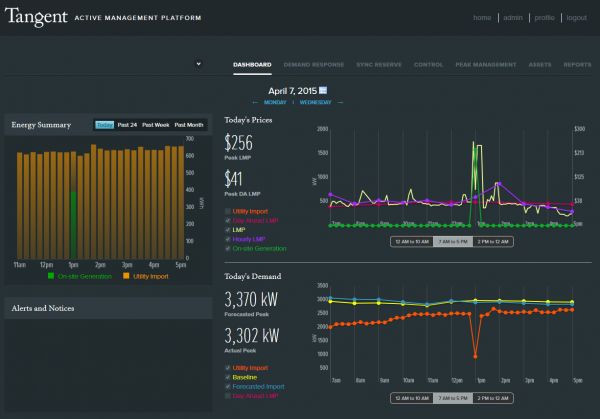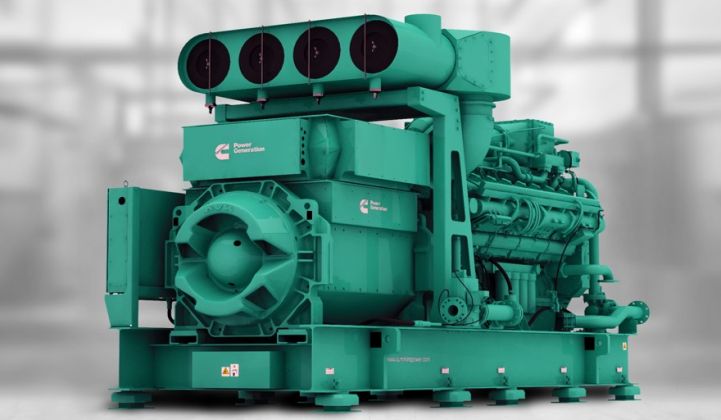GTM Research has identified generator makers like General Electric, Cummins and Generac as key players in the microgrid field. That makes sense, since they provide one of the cornerstone pieces of equipment for customer categories for which losing power isn’t an option, like data centers or hospitals.
But to earn their keep during the vast majority of time the power isn’t out, these generators are increasingly being hooked up with communications technology and software to use them for demand-charge management, bidding into energy markets, or as a resource to help stabilize the grid. That, in turn, can allow generator companies to bundle them into a service, complete with low-cost financing, to access a much broader set of customers.
That’s how Satish Jayaram, director of Cummins Energy Ventures, described the logic behind last week’s joint venture with distributed energy controls software company Tangent Energy. Under the terms of the agreement, Cummins will be offering its EdgeGEN generators pre-integrated with Tangent’s distributed energy resource management system, a class of software that can monitor and control them as a unified energy resource. The newly formed joint venture will be marketed as "edgeGEN."
The two companies have been working together for the past year and a half, integrating Tangent’s software into Cummins generators for a few customers. But “moving this to a joint-venture type model allows us to standardize our offering in the market, and make it sustainable for all customers," said Jayaram.
“I think the fundamental pivot from strategic partnership to joint venture is [that] the size of the opportunity was quite promising,” he said. Natural gas is cheap at present, and generators are getting cleaner in terms of emissions, allowing them to run in a wider set of circumstances. That’s making them a much-favored alternative to the diesel generators used in many emergency backup systems today.
At the same time, “Customers are getting much smarter in this DG space, and they’re looking for revenue assets” as well as backup power, he said. This is where Tangent comes in, with its ability to dispatch individual units based on a complex set of economic imperatives, like the price of energy now versus later in the day, or whether or not a customer is about to exceed peak demand limits.

Using generators as energy market assets isn’t new, Tangent CEO Dean Musser noted. They’ve been used for a decade or more by demand response (DR) companies like EnerNOC and Enerwise Global Technologies, the company he founded and sold to Comverge in 2007.
But “the market dynamics in the DR world are changing fairly rapidly,” he said. Diesel generators are being phased out in many jurisdictions, or banned entirely in others like California. At the same time, program rules and market imperatives are requiring demand response to act more quickly, and stay effective for longer periods of time, which can put strain on demand reduction -- turning things off, in other words -- as the sole tool used to meet DR calls.
“With clean natural-gas generation” -- a term that applies to SOX and NOX particulates, not to CO2 emissions, of course -- “we can operate to meet customers’ needs with no fatigue, for longer hours," said Musser. Today’s generators are also able to ramp up and down more efficiently to meet fast-changing shifts in the balance of energy supply and demand, whether across an entire transmission system or at the local grid level.
As for upfront cost, “A customer typically is not putting out any capital for this,” he said. “We work with channel partners that can monetize these systems in the marketplace,” including project developers, municipal governments and energy retailers, he added. This move is in keeping with the shift toward no-money-down financing for rooftop solar, behind-the-meter batteries and other distributed energy resources.
Cummins owns its own distribution business, unlike most of its generator-equipment competitors, which gives it an outlet for its generator-as-a-service model, Jayaram noted. It’s also been studying the opportunities for market share in the distributed energy field through its Energy Ventures unit, which was formed about three years ago. “Our mandate was to look at how the energy markets had evolved over the past four or five years, and how we wanted to play as we moved from centralized to distributed generation.”
Tangent is one of a host of companies offering software to coordinate and control distributed energy resources in this way. Startups including Enbala, Blue Pillar, Viridity Energy and others have deployed across megawatts of behind-the-meter energy resources, and are partnering with utilities and competitive energy retailers. On the microgrid side of the equation, grid giants like General Electric, Siemens, Schneider Electric and ABB are deploying projects, alongside a set of technology specialists such as Power Analytics, Spirae and Smarter Grid Solutions. Utilities are also getting into the game, as Southern Company did via its $431 million acquisition of PowerSecure, or Edison International has with its energy services business.



